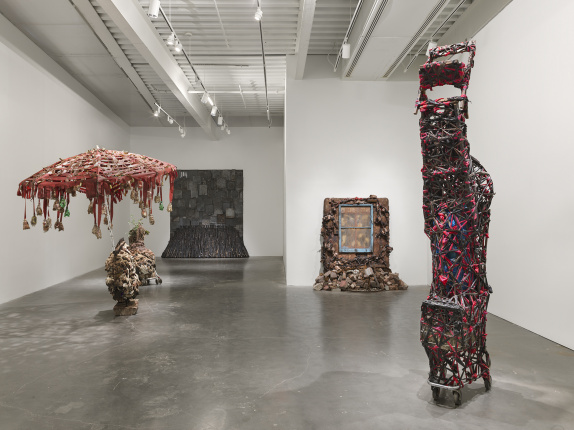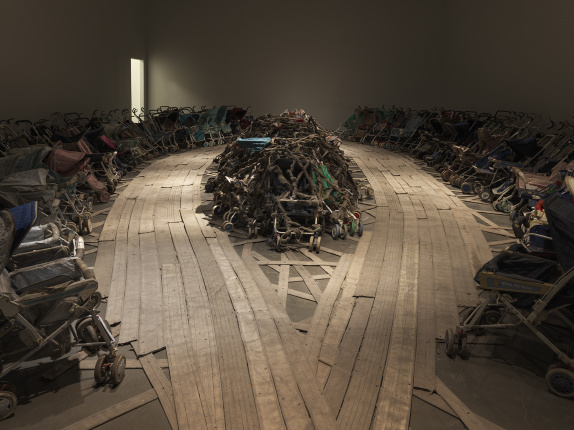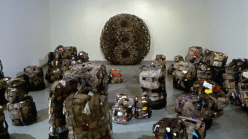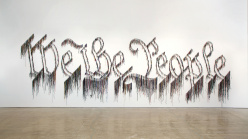The New Museum presents the first museum survey in New York of the work of Nari Ward (b. 1963, St. Andrew, Jamaica).
“Nari Ward: We the People,” 2019. Exhibition view: New Museum, New York. Photo: Maris Hutchinson / EPW Studio
Second Floor, Third Floor, and Fourth Floor Visit Us
Interested in learning more? Download the audio guide
“Nari Ward: We the People” features over thirty sculptures, paintings, videos, and large-scale installations from throughout Ward’s twenty-five-year career, highlighting his status as one of the most important and influential sculptors working today. Since the early 1990s, Ward has produced his works by accumulating staggering amounts of humble materials and repurposing them in consistently surprising ways. His approach evokes a variety of folk traditions and creative acts of recycling from Jamaica, where he was born, as well as the material textures of Harlem, where he has lived and worked for the past twenty-five years. Yet Ward also relies on research into specific histories and sites to uncover connections among geographically and culturally disparate communities and to explore the tension between tradition and transformation.
This presentation highlights the continued importance of New York, and Harlem in particular, to the material and thematic content of Ward’s art. Many of his early sculptures were created with materials scavenged from buildings and streets in Harlem. These items—baby strollers, fire hoses, baseball bats, cooking trays, bottles, and shopping carts—were chosen for their connection to individual lives and stories within the neighborhood. The exhibition includes several key early works, such as the large-scale environments Amazing Grace and Hunger Cradle (both 1993), which Ward made and exhibited in an abandoned firehouse. That same year, Ward had his first institutional solo exhibition at the New Museum, where he exhibited a dramatic large sculpture, Carpet Angel (1992).
In his more recent work, Ward directly addresses complex political and social realities that resonate on both a local and a national level, reflecting the profound changes gentrification has brought to Harlem and the increasingly fractured state of democracy in the United States. He uses language, architecture, and a variety of sculptural forms to reflect on racism and power, migration and national identity, and the layers of historical memory that comprise our sense of community and belonging. “Nari Ward: We the People” brings together many of Ward’s most iconic sculptures alongside a number of works that have not been seen in New York since they were originally created. The exhibition demonstrates Ward’s status as a key bridge between generations of American sculptors and a vital advocate for art’s capacity to address today’s most urgent issues.
Naturalization Drawing Table will be activated at the following times:
Friday March 1, 3–5 PM
Saturday March 16, 11:30–1:30 PM
Friday March 29, 3:30–5:30 PM
Saturday April 13, 11:30–1:30 PM
Friday April 26, 3:30–5:30 PM
Saturday May 11, 11:30–1:30 PM
Friday May 24, 3:30–5:30 PM
A fully illustrated catalogue copublished by the New Museum and Phaidon Press accompanies the exhibition. The catalogue includes an interview with Nari Ward conducted by Lowery Stokes Sims, an interview with Okwui Enwezor conducted by Massimiliano Gioni, and newly commissioned essays on the artist’s work by Bennett Simpson, Lauren Haynes, and Gary Carrion-Murayari.
“Nari Ward: We the People” is curated by Gary Carrion-Murayari, Kraus Family Curator; Massimiliano Gioni, Edlis Neeson Artistic Director; and Helga Christoffersen, Associate Curator.

















